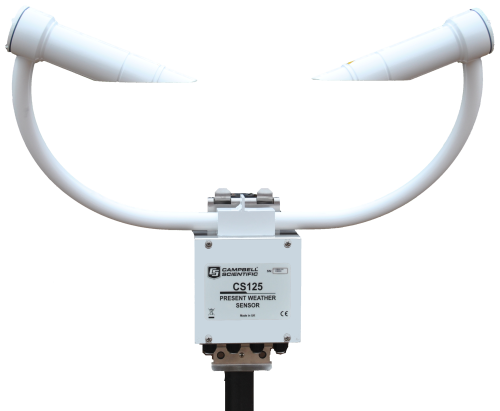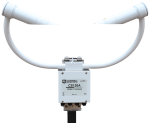
Ideal for transportation applications






Overview
The CS125 is an infrared forward-scatter visibility and present weather sensor for stand-alone use or with automatic weather stations including those for road, marine, and airport applications. The CS125 has an attached 5 m (16.4 ft) cable and DB9 connector.
Learn more about our CampbellAero™ Automated Weather Observing System (AWOS) Solution and our CampbellAero Software.
Read MoreBenefits and Features
- High performance sensor at a competitive price
- Sensor design minimizes airflow disruption at measurement volume
- Simple field calibration using optional calibration kit
- Low power - suitable for remote application
- Automatic status check for faults or window contamination
- Incorporates automatic dew and hood heaters for all-weather operation
- Type certified for aviation use by the German Meteorological Service, Deutscher Wetterdienst (DWD)
Images

Similar Products
Detailed Description
The CS125 uses the well-established forward scatter system for visibility measurement, using a 42° scatter angle, which gives accurate estimates of Meteorological Observable Range (M.O.R.) for fog and snow.
It identifies precipitation particles from their scattering properties and fall speeds, and combines this with a temperature measurement to identify the weather type. It has downward-pointing optics that reduce the risk of contamination of the optics and blockage with snow. Interference to the sample volume from the sensor by flow distortion or heat is minimized.
It also provides reliable present weather information in the form of SYNOP codes, including information on the intensity of precipitation. Accumulation can also be reported.
The CS125 uses continuous high-speed sampling to reduce errors during mixed-weather events and events that return intermittent signals, such as rain and hail, while still providing reliable readings during more stable events, such as fog and mist. The CS125 has high immunity to interference from the visible and infrared warning lights used to mark obstructions, such as wind turbines.
The sensor can be set to a lower sampling frequency to save power, if required.
The CS125 incorporates low-power dew prevention heaters, as well as higher-power anti-icing heaters for the hoods as standard. These heaters are automatically controlled to ensure operation in all weather, or they can be disabled individually to save power.
The CS125 continuously monitors its own status and will report internal faults and contamination or blockage of the sensor lenses. It also has two user-configurable alarm outputs that can be used to drive audio or visual alarms using solid-state relays.
The CS125 is certified by Deutscher Wetterdienst as suitable for use to control wind turbine obstruction light systems as specified by 506/04, General Administrative Rules for the Identification of Aircraft Obstructions.
Specifications
Operational |
|
| Maximum Reported Visibility | 100 km (62.1 mi) |
| Minimum Reported Visibility | 5 m (16.4 ft) |
| Resolution | 1 m (3.28 ft) |
| Outputs | Present and past weather: identifies as standard mist, fog, drizzle, freezing drizzle, drizzle and snow, rain, freezing rain, rain and drizzle, rain and snow, and snow. 57 SYNOP present weather codes and associated METAR and NWS present weather codes - hail detection; past weather codes. |
| Accuracy |
|
| Precipitation Detection Sensitivity | 0.05 mm/h |
| Accumulation Reporting Range | 0 to 999.9 mm (0 to 39.37 in.) |
| Accumulation Accuracy | ±15% (against factory calibration standards in the laboratory, for liquid precipitation) |
| Accumulation Resolution | 0.1 mm (0.0039 in.) |
| Rain Intensity Range |
0 to 999.9 mm/h (0 to 39.37 in./h) (The maximum intensity reported is dependent on the mixture of precipitation falling.) |
| Intensity Accuracy | ±15% (against factory calibration standards in the laboratory, for liquid precipitation) |
| Intensity Resolution | 0.01 mm/h (0.00039 in./h) |
| Operating Temperature Range | -25° to +60°C (standard) |
| Extended Operating Temperature Range | -50° to +70°C or -40° to +70°C |
| Operating Humidity | 0 . . . 100% |
| Operating Wind Speed | Up to 60 m/s |
| Sensor Sealing | Rated to IP66 |
| Total Unit Power | Less than 3 W while sampling continuously (including dew heaters) |
Mechanical |
|
| Material | Stainless steel and hard-anodized aluminum powder-coated |
| Mountings | Stainless-steel clip on V-bolt mounting to pole with diameter of 32 to 52.5 mm (1.26 to 2.07 in.) |
| Mounting Pole | An optical mounting pole is available to place the sample volume at 1.5 m (4.9 ft), as recommended by the WMO. |
| Frangible Mast | Frangible masts are available to customer requirements to meet ICAO recommendations (typically placing the sample volume at 2.5 m [8.2 ft]). |
| Visibility Sensor Dimensions | 540 x 640 x 246 mm (21.26 x 25.2 x 9.7 in.) including mount |
| Cable Length | 5 m (16.4 ft) |
| Sensor Weight | ~3 kg (6.61 lb) dependent upon mounting system |
Electrical |
|
| -NOTE- |
Lower power states can be achieved by less frequent sampling and remote control of heaters. Optional power supplies with battery backup available. Connectors in place of flying leads are available. A low-voltage shutdown level can be set to prevent backup batteries from being damaged. |
| Electronics Supply Voltage | 7 to 30 Vdc |
| Hood Heater Supply Voltage | 24 V (dc or ac) |
| Hood Heater Power | 2 x 30 W (total of 60 W) |
| Dew Heater Power | 2 x 0.6 W (total of 1.2 W) |
Interface |
|
| Serial Interface | RS-232 or RS-485 |
| Serial Data Rates | 1200 to 115,200 bps (38,400 bps default rate) |
| Alarm Outputs | 2 x 0 to 5 V outputs, 32 mA (max) |
Optical |
|
| -NOTE- |
Lens contamination circuity monitors both the source and detector lenses for contamination/blockage at 1 s intervals. The sensor can be configured to adjust calibration for low to moderate window contamination. Light source stability control ensures stable operation through variations in temperature and with sensor aging. Corrected at 1 s intervals. |
| Emitter Light Frequency | 850 nm |
Documents
Brochures
Case Studies
Downloads
CS125 and CS120A OS v.17 (555 KB) 08-06-2023
Campbell Scientific has introduced a new operating system, OS 17, for the CS120A visibility sensor and CS125 present weather sensor. It is backwards compatible and is easily installed on all CS120A and CS125 sensors (but not older CS120 sensors). OS 17 is available free of charge and can be downloaded here or supplied by email on request.
Upgrade to OS 17 is recommended.
Case Studies
Background Manitouwadge Municipal Airport is located 48 km (29.8 mi) north of highway 17 on Highway......read more
Tropical volcanic islands are biodiversity hotspots where the Critical Zone (CZ) remains poorly studied. In......read more
Campbell Scientific’s system integrator, AUDIMOBIL LDA, recently upgraded the airport weather system in the S.......read more
The Utah Department of Transportation (UDOT) operates a network of roadside weather stations across the......read more
AUDIMOBIL recently installed an Automatic Weather Station in a Portuguese Military Air Base, to support......read more
Articles and Press Releases
Newsletter Articles
Privacy Policy Update
We've updated our privacy policy. Learn More
Cookie Consent
Update your cookie preferences. Update Cookie Preferences





